Thanksgiving is the beloved fall holiday sandwiched between Halloween and Christmas. While some folks are already putting up their holiday tree and gleefully wrapping presents, an army of sweater-wearing, flannel-layering, harvest-loving home chefs are prepping their pantries and organizing a socially distanced Thanksgiving holiday. I just found out a few days ago that Thanksgiving is Cracker Barrel’s busiest day of the year, and right now, stores are taking orders for a pretty good heat-and-serve dinner package.
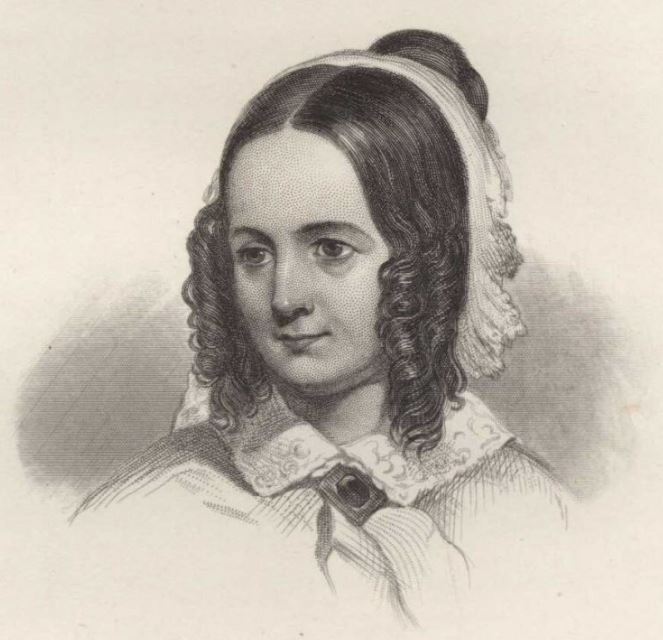 While it is true that Thanksgiving has its roots in American colonial history, the concept of a day set aside for food, drink and football was a localized tradition popular in the New England region of the country. So, how did Thanksgiving dinner appear on tables across the country? We need to thank author Sarah Buell Hale and the 16th President of the United States, Abraham Lincoln.
While it is true that Thanksgiving has its roots in American colonial history, the concept of a day set aside for food, drink and football was a localized tradition popular in the New England region of the country. So, how did Thanksgiving dinner appear on tables across the country? We need to thank author Sarah Buell Hale and the 16th President of the United States, Abraham Lincoln.
While days of Thanksgiving sporadically appeared throughout the American continent well before Hale was born, an annual celebration was absent from the yearly calendar. Hale did most of the heavy lifting to promote Thanksgiving as a much-needed national holiday. She spent nearly four decades campaigning and championing the Thanksgiving cause and detailed the holiday copiously in her 1827 book Northwood: A Tale of New England. Through her book’s descriptions, New Hampshire-reared Hale introduced readers from across the country to the sights and smells of a hearty, North East holiday spread.
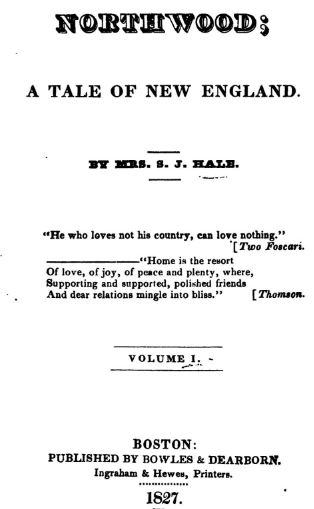 “The table, covered with a damask cloth, vieing in whiteness and nearly equaling in texture, the finest imported, though spun, woven and bleached by Mrs. Romelee’s own hand, was now intended for the whole household, every child having a seat on this occasion; and the more the better, it being considered an honor for a man to sit down to his Thanksgiving supper surrounded by a large family…
“The table, covered with a damask cloth, vieing in whiteness and nearly equaling in texture, the finest imported, though spun, woven and bleached by Mrs. Romelee’s own hand, was now intended for the whole household, every child having a seat on this occasion; and the more the better, it being considered an honor for a man to sit down to his Thanksgiving supper surrounded by a large family…
“The roasted turkey took precedence on this occasion, being placed at the head of the table; and well did it become its lordly station, sending forth the rich odor of its savory stuffing, and finely covered with the frost of basting. At the foot of the board, a sirloin of beef, flanked on either side by a leg of pork and joint of mutton, seemed placed as a bastion to defend innumerable bowls of gravy and plates of vegetables disposed in that quarter. A goose and a pair of ducklings occupied side stations on the table; the middle being graced, as it always is on such occasions, by that rich burgomaster of the provisions, called a chicken pie. This pie, which is wholly formed of the choicest parts of fowls, enriched and seasoned with a profusion of butter and pepper, and covered with an excellent puff paste, is, like the celebrated pumpkin pie, and indispensable part of a good and true Yankee Thanksgiving; the size of the pie usually denoting the gratitude of the party who prepares the feast.”
By 1854, Hale’s constant lobbying in multiple regions had established Thanksgiving as a local holiday in 30 states and territories. Her dream for a federal holiday remained elusive. Undeterred from her mission, Hale made a Thanksgiving-holiday sales pitch to then-president Abraham Lincoln in the fall of 1863. Lincoln grappled with the struggles of the Civil War and saw the advantage of adopting Thanksgiving as a federal holiday as a way to “heal the wounds of the nation.”
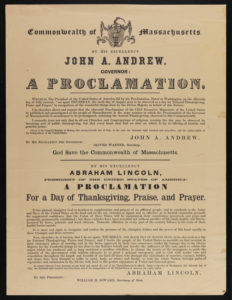 On October 3, 1863, after expressing gratitude for a pivotal Union Army victory at Gettysburg, President Abraham Lincoln announced the first official national celebration of the Thanksgiving holiday on Thursday, November 26, 1863. In his Thanksgiving Proclamation speech, Lincoln said:
On October 3, 1863, after expressing gratitude for a pivotal Union Army victory at Gettysburg, President Abraham Lincoln announced the first official national celebration of the Thanksgiving holiday on Thursday, November 26, 1863. In his Thanksgiving Proclamation speech, Lincoln said:
“Now, therefore, be it known, that I do set apart, THURSDAY, the sixth day of August Next, to be observed as a day for National Thanksgiving, Praise and Prayer; and I invite the people of the United States to assemble on that occasion in their customary places of worship, and in the forms approved by their own conscience, render the homage due to the Divine Majesty for the wonderful things he has done in the Nation’s behalf, and invoke the influence of His holy spirit to subdue the anger, which has produced and so long sustained a needless rebellion; to change the hearts of the insurgents, to guide the counsels of the government with wisdom adequate to so great a national emergency, and to visit with tender care and consolation throughout the length and breadth of our land all those who through the vicissitudes of marches, voyages, battles, and sieges have been brought to suffer in mind, body, or estate; and finally, to lead the whole National, through paths of repentance and submission to the Divine will, back to the perfect enjoyment of Union and fraternal peace.”
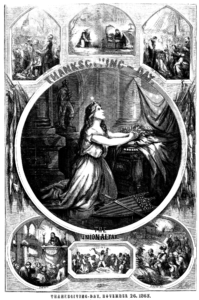 Harpers Weekly magazine published a copy of the Thanksgiving Day proclamation, as well as a gorgeous illustration of Lady Liberty kneeling in prayer. For people who could neither read nor write, this visual representation of the holiday proclamation was placed in homes across the country.
Harpers Weekly magazine published a copy of the Thanksgiving Day proclamation, as well as a gorgeous illustration of Lady Liberty kneeling in prayer. For people who could neither read nor write, this visual representation of the holiday proclamation was placed in homes across the country.
To learn more about how Thanksgiving became a national holiday, we are hosting Lincoln and Thanksgiving, a free virtual presentation on Wednesday, November 11, at 7 pm. Reenactor Kevin Wood will tell the story of how our annual observance of Thanksgiving was established during the 16th President’s tenure and will answer questions submitted by participants. This fantastic family program aimed at anyone aged seven or older. Register for the program online or by calling the 3rd Floor Reference Desk at 630.685.4176. A link for the program will be emailed to attendees one day before and again one hour before the program.
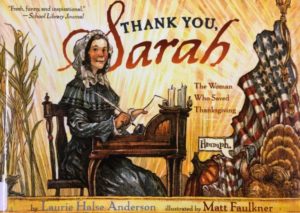 If you are looking for a good book recommendation to share the Thanksgiving story with your little ones, check out Thank you, Sarah! The Woman Who Saved Thanksgiving by Laurie Halse Anderson. This children’s picture book is a delightfully written account of Sarah Buell Hale’s doggedly determined mission to establish the Thanksgiving we love and enjoy today. A fun and enjoyable read for the whole family, this book is an excellent supplement to some of the other Thanksgiving titles you may have on your list to read. Even if you don’t have any kids in the house, you’ll definitely want to check this book out! You can pick up a copy of this book from our Children’s Department.
If you are looking for a good book recommendation to share the Thanksgiving story with your little ones, check out Thank you, Sarah! The Woman Who Saved Thanksgiving by Laurie Halse Anderson. This children’s picture book is a delightfully written account of Sarah Buell Hale’s doggedly determined mission to establish the Thanksgiving we love and enjoy today. A fun and enjoyable read for the whole family, this book is an excellent supplement to some of the other Thanksgiving titles you may have on your list to read. Even if you don’t have any kids in the house, you’ll definitely want to check this book out! You can pick up a copy of this book from our Children’s Department.
See You At The Library!
